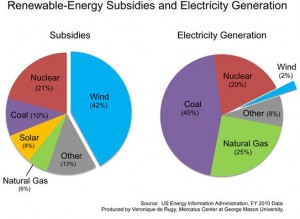The Free Market’s Key Investment in Renewable Energy
This past week Walmart signed a historic deal with Plug Power, ordering nearly 1800 hydrogen powered fuel cells. The cells will be given to distribution centers in order to power their factory vehicles such as forklifts and will be an addition to the 500 they already have operating. Hydrogen fuel cells work by turning both hydrogen and oxygen into electricity. Walmart also bought a significant part of their GenFuel infrastructure, including a 6-year service contract for each site. The landmark deal’s numbers are not exact, but analysts report that it is close to $50 million dollars.
While the government does provide incentives for many renewable energy projects, in this case Walmart will not receive subsidies. Since it is just the batteries they are buying, the upgrades are the cost to Walmart directly. The government has seen huge failures in subsidy programs including agricultural and energy related funds. Agricultural subsidies due to the 2002 Farm Bill, drove prices up substantially over the 10 years it existed and renewable energy experienced a similar effect. The amount of subsidies received is directionally disproportionate to the amount of electricity they created. 2010 numbers show that solar and wind power specifically were unable to create the impact under subsidies that was expected. Solar energy in particular is not even on the other chart because its output was so statistically low. However, since a majority of the subsidies have ended there have been an increased number of investors. The most recent example was Google buying solar farms to power their buildings and invest further in technologies such as solar panels and the popular thermostat, Nest.
It is a turning point in the industry as renewable energies such as hydrogen fuel cells have finally advanced enough for it to be used as a viable source for energy. While the government continues to try to subsidize alternative energy research, the market is making swift moves towards their own objectives. With such recent partnerships between Ford and Honda to research cheaper refueling methods it has been a race to hit the market. Toyota has seen great success with the Prius, and now there’s a demand for hydrogen power. Nokia and Sprint are also entrants into hydrogen power by switching from diesel generators to hydrogen powered generators. These generators will provide a backup for rooftop sites for their wireless networks in order to maintain coverage in cases of emergency.
Thanks to large corporate participation, the economy could see hydrogen powered vehicles on the road much sooner than expected. This only goes to prove that a free market can in fact introduce renewable energy without and better than government.

“The government has seen huge failures in subsidy programs including agricultural and energy related funds.”
An understatement!
“This only goes to prove that a free market can in fact introduce renewable energy without and better than government.”
Exactly. All it takes is a juggernaut like Walmart to get on board.
Walmart > Government
Proof that everything does not need a subsidy. Once companies realize the benefits, free markets will lead the way.
“While the government continues to try to subsidize alternative energy research.”
Of course they are.
I enjoy watching the government failed attempts at this while the free market thrives in alternative energy investment.
I was stunned by your chart showing coal gets a bigger government subsidy than solar!